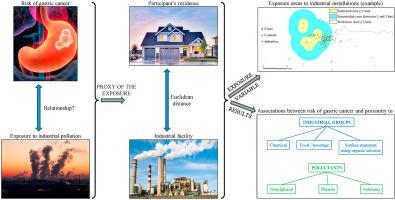Environmental Pollution ( IF 8.9 ) Pub Date : 2021-03-03 , DOI: 10.1016/j.envpol.2021.116854 Javier García-Pérez , Virginia Lope , Nerea Fernández de Larrea-Baz , Antonio J. Molina , Adonina Tardón , Juan Alguacil , Beatriz Pérez-Gómez , Víctor Moreno , Marcela Guevara , Gemma Castaño-Vinyals , José J. Jiménez-Moleón , Inés Gómez-Acebo , Ana Molina-Barceló , Vicente Martín , Manolis Kogevinas , Marina Pollán , Nuria Aragonés

|
Background
Gastric cancer is the fifth most frequent tumor worldwide. In Spain, it presents a large geographic variability in incidence, suggesting a possible role of environmental factors in its etiology. Therefore, epidemiologic research focused on environmental exposures is necessary.
Objectives
To assess the association between risk of gastric cancer (by histological type and tumor site) and residential proximity to industrial installations, according to categories of industrial groups and specific pollutants released, in the context of a population-based multicase-control study of incident cancer conducted in Spain (MCC-Spain).
Methods
In this study, 2664 controls and 137 gastric cancer cases from 9 provinces, frequency matched by province of residence, age, and sex were included. Distances from the individuals’ residences to the 106 industries located in the study areas were computed. Logistic regression was used to estimate odds ratios (ORs) and 95% confidence intervals (95%CIs) for categories of distance (from 1 km to 3 km) to industries, adjusting for matching variables and potential confounders.
Results
Overall, no excess risk of gastric cancer was observed in people living close to the industrial installations, with ORs ranging from 0.73 (at ≤2.5 km) to 0.93 (at ≤1.5 km). However, by industrial sector, excess risks (OR; 95%CI) were found near organic chemical industry (3.51; 1.42–8.69 at ≤2 km), inorganic chemical industry (3.33; 1.12–9.85 at ≤2 km), food/beverage sector (2.48; 1.12–5.50 at ≤2 km), and surface treatment using organic solvents (3.59; 1.40–9.22 at ≤3 km). By specific pollutant, a statistically significant excess risk (OR; 95%CI) was found near (≤3 km) industries releasing nonylphenol (6.43; 2.30–17.97) and antimony (4.82; 1.94–12.01).
Conclusions
The results suggest no association between risk of gastric cancer and living in the proximity to the industrial facilities as a whole. However, a few associations were detected near some industrial sectors and installations releasing specific pollutants.
中文翻译:

在MCC-西班牙研究中,工业设施环境中的胃癌风险
背景
胃癌是全球第五大最常见的肿瘤。在西班牙,它的发病率存在很大的地理差异,这表明环境因素可能在其病因中发挥作用。因此,针对环境暴露的流行病学研究是必要的。
目标
在基于人群的多发病例癌症研究中,根据工业集团的类别和释放的特定污染物,评估胃癌风险(按组织学类型和肿瘤部位)与居民居住在工业设施之间的关联性在西班牙(MCC-西班牙)进行。
方法
本研究纳入了来自9个省的2664例对照和137例胃癌病例,频率与居住地,年龄和性别相匹配。计算了从个人住宅到研究区域内106个行业的距离。使用逻辑回归来估计距行业(从1 km到3 km)的类别的比值比(OR)和95%置信区间(95%CI),并调整匹配变量和潜在的混杂因素。
结果
总体而言,在靠近工业设施的人群中未观察到胃癌的额外风险,OR范围为0.73(≤2.5km)至0.93(≤1.5km)。然而,按工业部门,在有机化学工业(3.51;≤2km处为1.42–8.69),无机化学工业(3.33;≤2km处为1.12–9.85)附近发现了超额风险(OR; 95%CI)。饮料部门(≤2 km时为2.48; 1.15-5.50),以及使用有机溶剂进行表面处理(≤3 km时为3.59; 1.40–9.22)。通过特定污染物,在(≤3km)工业附近发现释放壬基苯酚(6.43; 2.30-17.37)和锑(4.82; 1.94-12.01)的统计上显着的过高风险(OR; 95%CI)。
结论
结果表明,患胃癌的风险与生活在整个工业设施附近的人群之间没有关联。但是,在一些工业部门和释放特定污染物的设施附近发现了一些关联。



























 京公网安备 11010802027423号
京公网安备 11010802027423号